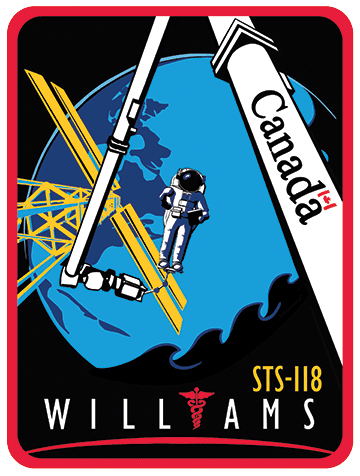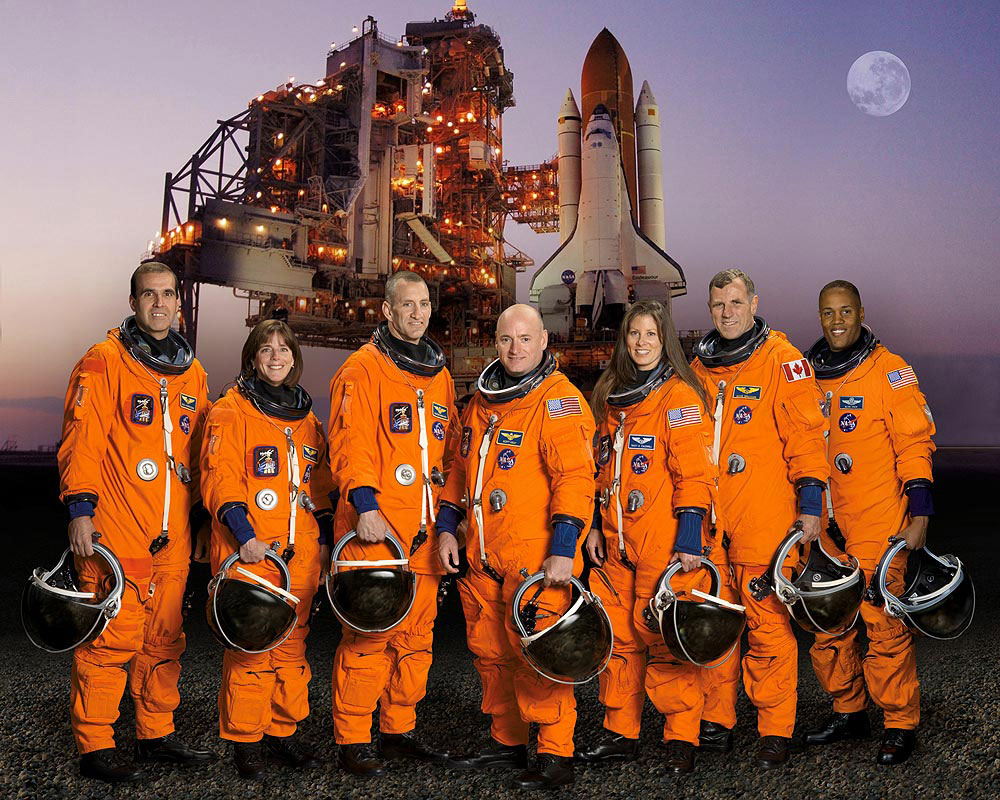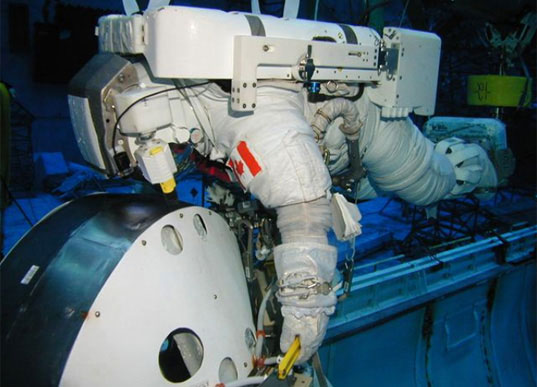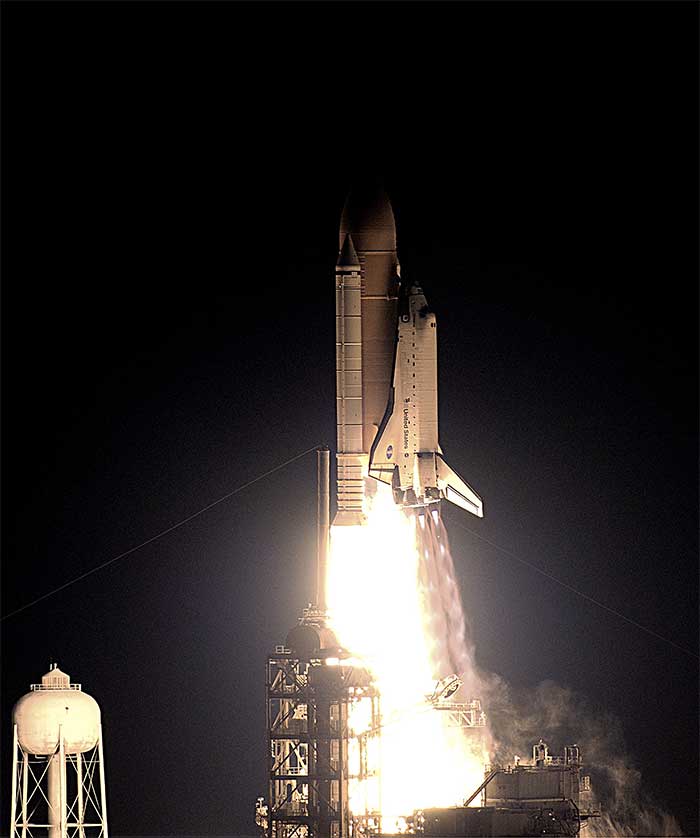Mission STS-118

Mission description

Text version
This patch celebrates Canada's role in STS-118, the 22nd assembly mission of the International Space Station (ISS). It depicts Canadian Space Agency (ASC) astronaut Dr. Dave Williams installing the S5 truss segment to the backbone of the ISS. It marks his role as the only Canadian to perform three spacewalks in support of a human space mission.
The Station's stylized solar arrays symbolize an infinite quest for knowledge through exploration. The inclusion of waves in the design, an ancient symbol of exploration, draws attention to the history of sea and space discovery while highlighting Dr. Williams' experience as the first Canadian to be both an astronaut and an aquanaut.
The STS-118 appears just above the MS in WILLIAMS to underscore his role as Mission Specialist. The caduceus, symbolizing medicine, appearing in Dr. Williams' name represents his pride in being a physician and his role as crew medical officer during the flight. This Canadian emblem was designed by Mustapha Kerouch, a Faculty of Engineering student at McGill University in Montreal.
Patch STS-118. (Credit: Canadian Space Agency)
Launch
Date: August 8, 2007
Time: 6:36 p.m. (ET)
Landing
Date: August 21, 2007
Time: 12:33 p.m. (ET)
Site: Kennedy Space Center
Mission duration: 12 days 17 h 55 min
Orbiter vehicle: Endeavour
Flight number: STS-118
Launched on August 8, 2007, the top priority of mission STS-118 is to deliver and assemble the S5 truss segment to the International Space Station (ISS). The 11 + 3 day mission marks the 22nd shuttle trip to the ISS, and the 20th flight of space shuttle Endeavour.
Canada's contribution is once again crucial. During the mission, astronaut Dave Williams, a veteran of shuttle mission STS-90, will set a Canadian record by spending over 19 hours outside the space station during three scheduled spacewalks. In addition, Canadian-made robotics and sensor technologies will help ensure the success of the mission and the safety of the shuttle and crew.
This summer, Canadian innovation and ingenuity will be in the spotlight as the crew of the space shuttle Endeavour launches into space to continue the challenging task of assembling the world's biggest and most ambitious engineering project, the ISS.
Joining Canadian Dave Williams on STS-118 will be Commander Scott Kelly (veteran of mission STS-103), Pilot Charles Hobaugh (STS-104), and mission specialists Richard Mastracchio (STS-106), Tracy Caldwell, Benjamin Alvin Drew and Barbara Morgan, NASA's first Educator-Astronaut. As the very first Educator astronaut, Barbara Morgan will use NASA's "Teacher in Space" program to inspire and engage students by providing a bridge between space exploration and their classrooms.

Mission STS-118 crew
From left to right. Richard A. (Rick) Mastracchio, mission specialist; Barbara R. Morgan, mission specialist; Charles O. Hobaugh, pilot; Scott J. Kelly, commander; Tracy E. Caldwell, Canadian Space Agency's Dafydd R. (Dave) Williams, and Alvin Drew Jr., all mission specialists. (Credit: NASA)
Building the Station from the ground up
Transport and assembly of vital equipment for the ISS is the most critical part of the STS-118 mission. Tasks for Dave Williams and the crew include delivery and construction of the S5 truss segment, a 3.2 m by 4.5 m aluminium structure at a weight of approximately 5000 lb. (2267.96 kg); the external stowage platform three (ESP3), an external pallet that can securely hold spare parts or Orbital Replacement Units for the station; and, a replacement Control Moment Gyro, an attitude control device used to control the orientation of the station. The crew will also deliver supplies and equipment via the SPACEHAB single cargo module riding in Endeavour's payload bay.

In addition, the crew will also work to assemble the Station-Shuttle Power Transfer System (SSPTS), an upgraded power distribution module that will allow the shuttle to draw power from the ISS power supply. Mission managers for STS-118 could add three more days and an additional spacewalk after the SSPTS is activated and checked out.
Canadian astronaut to participate in three spacewalks
When members of the crew don their spacesuits and prepare to head out into the dark reaches of space, Canadian talent will be front and centre. Astronaut Williams will participate in three of the four planned spacewalks, more than any other Canadian astronaut during a single mission, all while installing vital equipment and moving pieces of hardware around the station. During these spacewalks, it's estimated that Williams will spend about 19.5 hours in his spacesuit, floating in the vacuum of space. (Only if the SSPTS works as planned, will astronaut Williams perform three spacewalks: EVA1, EVA2 and EVA4.)
On flight day four (FD4), he will step out of the station marking Canadian space history as he joins Canadian astronauts Chris Hadfield and Steve MacLean in the limited club of spacewalkers. Although he may be struck by the beauty of the scenery, much work will need to be accomplished. For one, the spacewalkers Dave Williams and Rick Mastracchio will provide visual cues to Charles Hobaugh at the controls of the Canadarm2 as he attempts to lock into place the S5 truss. While cameras are essential for the operation, the astronauts' indications will be critical to properly line up the structures to ensure successful assembly.

Dave Williams replacing the Control Moment Gyro during a simulated spacewalk in the Neutral Buoyancy Laboratory (NBL) at the Johnson Space Center in Houston, Texas. (Credit: NASA)
The second spacewalk scheduled for flight day six (FD6) will be the highlight for Dave Williams. Not only will he be doing a second spacewalk, he will also be riding the Canadarm2 during most of the walk. A Canadian at the end of a Canadian technology masterpiece... a true picture of Canadian success! For this walk, astronaut Williams will work to replace the station's Control Moment Gyro (CMG) 3 (as illustrated in the picture above). Attached to the end of the Canadarm2, he will lift the CMG, similar in size to a washing machine, and move it from the shuttle payload bay to the Z1 truss (located near the center of the Integrated Truss Structure) where it will replace a defective CMG.
Dave Williams will take part in his third spacewalk, setting a Canadian record for the longest time spent outside in space, on flight day ten as he will be part of the mission's fourth spacewalk. Tasks for this walk include installing the support equipment for the Orbiter Boom Sensor System (OBSS) on the S1 truss and mounting new hardware on the station.
In addition to spacewalking, Dave Williams will conduct a Canadian scientific experiment called "Perceptual Motor Deficits in Space" (PMDIS). The experiment, designed to measure astronauts' eye-hand coordination while they are in space, marks the first time a Canadian performs the test in space.
Canadian technology: ensuring the safety and success of the mission
As soon as the Shuttle reaches orbit, Canadian technology comes into action to ensure the safety of the shuttle and its crew. From day one to day three of the mission, MDA's OBSS—a Canadian-made 15-metre extension of the shuttle's Canadarm—is teamed up with Neptec's Canadian-made laser camera to help the crew examine the shuttle for any sign of damage that could jeopardize the shuttle during re-entry. The OBSS gives the crew the crucial reach they need to inspect the hard-to-see areas of the shuttle, including the thermal tiles on its underside.

Canadian handoff of the P5 truss section during mission STS-116 in December 2006. (Credit: NASA)
Once docked to the station, the Canadarm2 will play a critical role in the assembly operations. The arm will be deployed in three of the four spacewalks to help the astronauts complete a range of complex tasks, including the assembly of the S5 truss segment, transporting Dave Williams for 6.5 hours as he replaces the station's Control Moment Gyro 3, and the transfer of the ESP-3. Operations of the Canadarm2 are controlled by operators via a Canadian-built robotic workstation located inside the station's U.S. Laboratory module Destiny.
During this flight, the renowned Canadarm and its next generation arm, the Canadarm2, will work hand-in-hand bringing support to the astronauts in building the ISS. On flight day three, the two robotic devices will execute a "robotic handshake" as the Canadarm picks up the S5 truss segment from the shuttle's payload bay and deftly passes it to the Canadarm2 in preparation for installation. On flight day seven , the same operation using both arms will be repeated to reposition the ESP-3. During this particular manoeuvre, as the Canadarm2 grapples the platform, the arm will provide it power in order to get video feedback from ESP-3 cameras. This will be a first time attempt and will provide new types of images to Charles Hobaugh at the controls of the Canadarm2.
Canadian flight controllers at the Johnson Space Centre in Houston, Texas, and the Canadian Space Agency headquarters in Longueuil, Quebec, also provide essential support for the space robotics operations. Working closely with the STS-118 crew, the Canadian controllers oversee the robotic activities ensuring that the complex operations of the Canadarm2 go exactly as planned.
Canadian space program continues to grow
From the very beginning, Canada has played a leading role in the creation of the space station. Mission STS-118 strengthens Canada's growing involvement with the ISS, utilizing Canadian talent and technology on a higher scale than ever before.
In less than a year, Canada's third and final element of its contribution to the ISS, Dextre, a two-arm robot, will be sent, assembled in space and ready to be activated. It will provide an alternative to spacewalking astronauts, considerably reducing the amount of time that they have to venture out of the space station to perform demanding tasks in a hostile environment, and providing more time for them to perform science. Dextre will be flown to space as part of mission STS-123, currently set for launch in 2008.

Dextre, Special Purpose Dexterous Manipulator (Credit: NASA)
